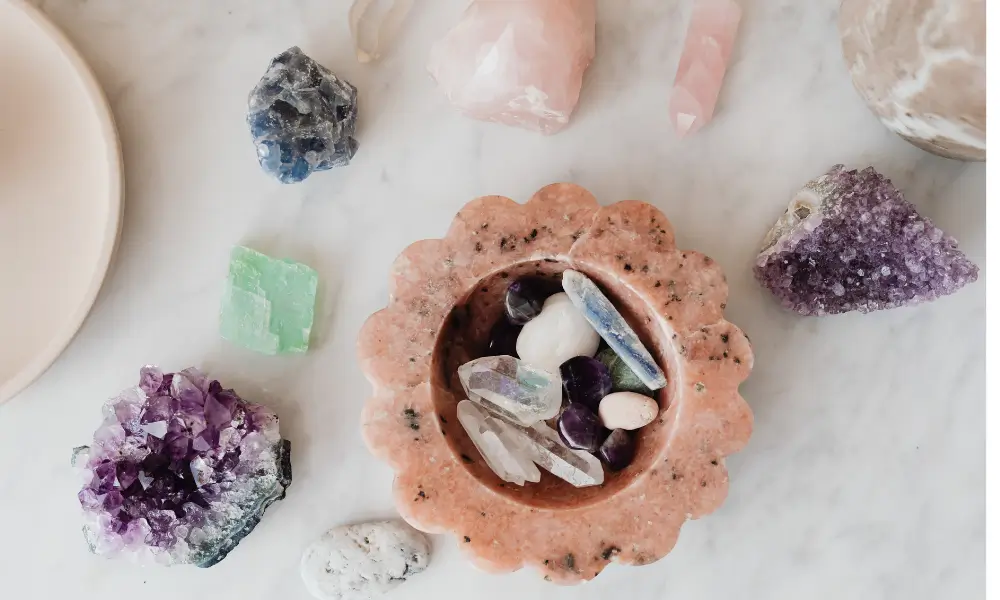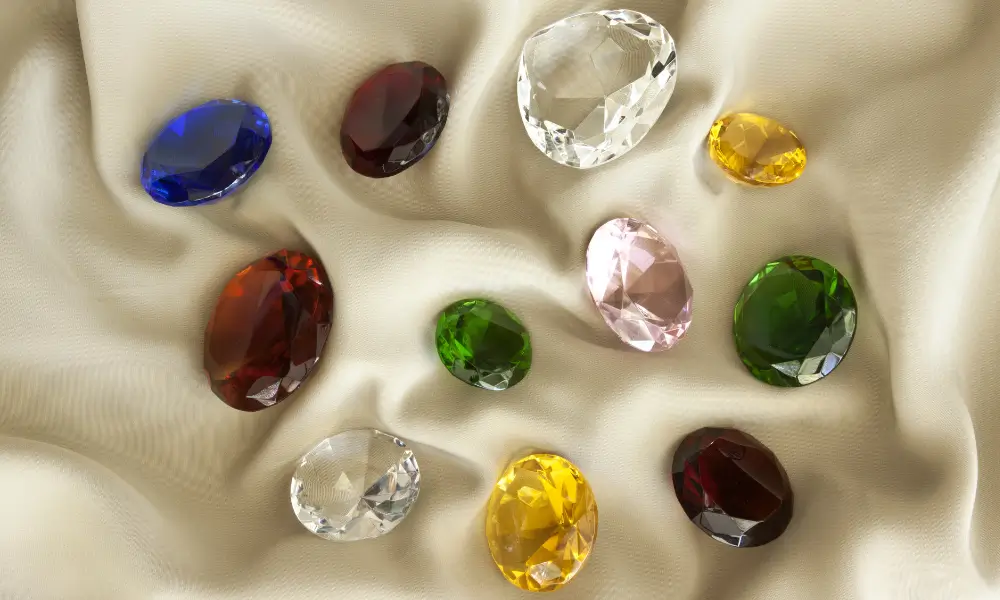What’s the Difference Between a Gemstones and a Crystal?
Gemstones are polished crystals used for beauty or value, while crystals are raw, naturally formed minerals. Many people confuse the two, especially when shopping or exploring healing practices. Crystals form naturally in the earth, but only the rare, clear, and durable ones are shaped into gemstones. For example, raw quartz is a crystal, while cut and polished amethyst is a gemstone.
Knowing the difference helps with buying decisions, energy work, and understanding value. This guide explains how crystals form, how gemstones are selected, and how to tell them apart.
What Is a Crystal?
A crystal is a naturally formed solid mineral with atoms arranged in a repeating, organized pattern. This internal structure is what gives crystals their unique shapes and properties.

Scientific Definition and Structure
A crystal is a solid material whose atoms are arranged in a repeating, fixed pattern. This pattern continues in all directions, giving the crystal its unique shape and physical properties.
Crystals form naturally over time through geological processes such as cooling, evaporation, or pressure deep within the Earth. As minerals grow under the right conditions, they start to form ordered structures. These structures can grow slowly over thousands or even millions of years.
Key features of a crystal include:
- A consistent geometric shape
- A certain level of hardness, depending on the mineral
- Growth that often starts from a single point and spreads outward
Types of Crystals
Crystals come in different forms and appearances. Some grow alone as single crystals, while others form in groups known as clusters. Clusters can have many small points growing together from the same base.
Crystals can also be:
- Transparent, like clear quartz
- Opaque, like black tourmaline
- Colored, like amethyst or citrine
- Colorless, like pure clear quartz
Natural crystals are widely used in both energy work and scientific fields. People may choose different types based on how they look or what they’re used for. In spiritual practices, color and shape are often linked to specific meanings or purposes.
Crystals in Daily Use
Crystals are found in many parts of daily life, not just in collections or healing:
- Quartz is used in watches and clocks to keep accurate time through steady vibrations
- Silicon crystals are essential in computers, smartphones, and other electronics for data storage and processing
- Decorative crystals like amethyst or rose quartz are often placed in homes or offices for beauty or energy
- Healing crystals are used by some people for emotional balance, focus, or stress relief during meditation or daily routines
- Educational use includes crystal samples in schools or museums to teach about geology and mineral formation
What Is a Gemstone?
A gemstone is a piece of mineral or crystal that has been cut, shaped, and polished to be used in jewelry or decoration. While all gemstones come from natural materials, not every crystal becomes a gemstone.

From Raw Crystal to Gemstone
A gemstone is a mineral, rock, or organic material that has been cut, shaped, and polished to enhance its appearance. The process turns a raw piece of earth into something ready to wear or display.
Not all crystals or minerals can become gemstones. For that to happen, the material must meet certain conditions. It needs to have:
- Good clarity (few or no visible flaws)
- Enough hardness to resist scratching
- A pleasing or rare color
- Some level of rarity in nature
Types of Gemstones
Gemstones are grouped by type, source, and value. The most well-known division is between precious and semi-precious stones.
Precious Gemstones
Precious gemstones are the most rare and valuable. These include:
- Diamond
- Ruby
- Emerald
- Sapphire
Semi-precious Gemstones
Semi-precious gemstones are more common but still beautiful and widely used. These include:
- Amethyst
- Garnet
- Peridot
- Topaz
Organic Gemstones
Organic gemstones are not minerals but are still classified as gemstones due to their use and beauty. These include:
- Pearl
- Amber
- Coral
Synthetic or lab-created gemstones are made by humans to look and feel like natural ones. They have the same structure and appearance but are often more affordable. Lab-grown diamonds and sapphires are common examples. These are real gemstones in terms of material, but not naturally formed on the Earth.
Each type has its own look, history, and purpose, but all are valued for their color, shine, and strength.
Where Gemstones Are Used
Gemstones are used in many parts of life, not just in jewelry. Their beauty and symbolism make them part of human culture across time.
- Jewelry is the most common use. Rings, earrings, necklaces, and bracelets often feature gemstones.
- Collecting is another reason people buy gemstones. Some collect them based on birth month, region, or color.
- Birthstones and symbolic gifts connect gemstones to personal meaning. Each month has a gemstone linked to it.
- Cultural and ceremonial use includes gemstones in crowns, religious items, and family traditions. In some cultures, gemstones are believed to bring luck, protection, or healing.
Gemstones are more than just shiny stones. They carry value, emotion, and history, shaped by the earth and refined by human hands.
Key Differences Between Crystals and Gemstones
Crystals and gemstones may come from the same source, but they serve different purposes and look very different in real life.
Visual and Physical Traits
Crystals are raw, rough, and often unpolished. They form naturally and keep their original shapes with uneven edges. Gemstones are cut, smooth, and polished. They are shaped to reflect light and highlight color. A simple test is to check the shape, shine, and surface. Crystals look natural and uneven. Gemstones are shiny and symmetrical.
Usage and Purpose
Crystals are used in healing, display, and electronics. People choose them for energy work or meditation.
Gemstones are mainly used in jewelry and gifts. They are worn for their beauty and meaning. Gemstones usually have higher market value due to cutting, clarity, and polish.
Real-World Example Comparisons
A quartz crystal cluster is raw with sharp points. A faceted amethyst pendant is smooth and shaped.
A rough sapphire rock looks dull and uneven. A sapphire ring shows the same stone, but polished and bright.
How Crystals Become Gemstones
Not all crystals become gemstones. Only those with the right quality are selected and shaped.
Criteria for Selection
A crystal must have rarity, clarity, color, and hardness to be turned into a gemstone. Natural conditions like heat and pressure affect these features. Most crystals do not meet the standard, so only a few are used as gemstones.
The Cutting and Polishing Process
Once chosen, the crystal goes through cutting and polishing. Cutting shapes the stone and adds sparkle. Polishing smooths the surface and improves shine. This process brings out the best features and makes the stone ready for jewelry or display.
Buying Tips and Common Mislabeling
Many buyers confuse crystals and gemstones because of poor labeling or marketing tricks. Knowing what to look for helps you make better choices and avoid overpaying.
How to Spot the Difference in Stores
Crystals often look rough and uneven, while gemstones are smooth and polished. Price can also hint at the difference, with gemstones costing more. Watch for vague labels like “healing gem” that don’t name the actual mineral.
Protecting Yourself as a Buyer
Ask if the stone is natural, dyed, or lab-created. Look for even cuts, shine, and where it came from. For valuable pieces, check for certifications or trusted mineral names to avoid fakes.
Raw Crystals vs Polished Gemstones in Energy Work
Raw crystals are thought to hold strong, natural energy because they come straight from the earth without shaping. People often use them in spaces like bedrooms or meditation corners.
Polished gemstones, on the other hand, are easier to carry and are said to be better for daily grounding or focus, like holding in your hand or wearing in jewelry.
Some believe that raw shapes feel more intense, while polished ones feel calm and steady.
The choice depends on the person. Some prefer rough textures for rituals, while others like smooth stones for their calming feel.
Neither one is better for everyone. It’s more about how you plan to use it and what feels right to you.
Common Myths and Misunderstandings
People often mix up words or assume things that aren’t true when it comes to crystals and gemstones. Here are two of the most common misunderstandings.
All Crystals Are Gemstones — False
Not every crystal is a gemstone. This is a common mix-up, especially in shops or online. Think of it like this: all squares are rectangles, but not all rectangles are squares. In the same way, some crystals can become gemstones, but most do not. The mix-up happens because people see shiny rocks and call them gemstones, even if they’ve never been cut or polished.
Crystals Have No Value — Also False
This idea is also wrong. Some raw crystals are actually rare and expensive. Value depends on things like size, color, clarity, and origin. For example, a large clear quartz cluster or deep purple amethyst can be worth a lot. Just because it is not shiny or cut does not mean it has no value. Some uncut crystals are more valuable than low-grade polished stones.
Conclusion:
Crystals and gemstones may come from the same earth, but they serve different roles in our lives. Crystals are raw, naturally formed minerals that carry unique shapes and energies. Gemstones are selected crystals that are cut and polished for beauty, value, and jewelry.
Understanding the difference helps you shop smarter, practice energy work more intentionally, and appreciate the science and art behind each piece. Whether you’re drawn to the rough power of a crystal or the polished elegance of a gemstone, both have meaning and purpose. Let your needs, goals, and intuition guide your choice.
FAQs
1: Are raw crystals more powerful for healing?
Ans: Many believe raw crystals carry stronger natural energy, while polished gemstones are preferred for ease of use and daily wear.
2. How can I tell if I’m buying a real gemstone or crystal?
Ans: Check for clear labeling, ask if it’s natural or treated, and look for certifications or known mineral names.
3. Can a crystal lose its energy if it’s cut or polished?
Ans: Some believe polishing changes the crystal’s energy slightly, while others feel it simply makes it easier to carry or wear.
4. Are all gemstones made from crystals?
Ans: Not always. Most gemstones start as crystals, but not all crystals qualify as gemstones. Some are too soft or not clear enough to be cut and polished.
5. Are all gemstones used for healing?
Ans: Not necessarily. Many gemstones are used mainly for decoration or jewelry, but some people also use them in spiritual or healing practices.
